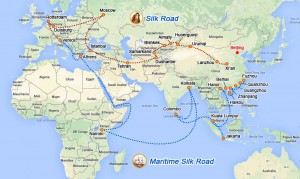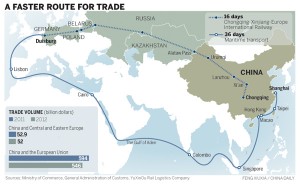In 2013, Chinese unveiled its plan to reinvigorate the ancient Silk Roads which connects Asia and Europe with modern infrastructure across regions. The plan, known as “One Belt One Road” has now become a priority of China’s foreign policy and its geopolitical coverage extends to countries and cities in Asia, Middle East, Africa and Europe. As Chinese President Xi Jinping said in 2014 during his visit in Europe, he was referring to the economic belt and said China would cooperate with Europe so as to integrate European and Asian markets and to make China and the EU the twin engines for global economic growth. Although some analysts comment that it is too early to see if China would be able to achieve much planned, it is beyond doubt that the New Silk Road scheme will affect Europe.
Overview of One Belt One Road
The overall plan consists of two parts: “Silk Road Economic Belt” and “21st Century Maritime Silk Road” and it is known as “One Belt One Road” (OBOR) in short. In the vision and action plan announced by the Chinese government in March 2015, it entails the whole strategy framework and 5 areas of actions.
Three routes covered in the “Silk Road Economic Belt are: 1) From China via Central Asia and Russia to Europe; 2) From China to Central and Western Asia to Persian Gulf and Mediterranean Sea; 3) China to Southeast Asia, South Asia and Indian Ocean. 1
For the “21st Century Maritime Silk Road”, it will focus on two routes: 1) From Chinese coastal cities, via South China Sea to Indian Ocean, extending to Europe; 2) From Chinese coastal cities, via South China Sea to South Pacific.
According to its “Vision and Action”, the Chinese government plans to enhance cooperation in the following 5 areas. 1) Policy Communication: To establish intergovernmental communication mechanism to deepen common interest and promote trust and mutual consensus. 2) Connecting via infrastructure:
To enhance connectivity along the routes, huge investment will be made on infrastructure likes road, railway, canal, port, energy transfer network and information and communication technology network. 3) Facilitation of investment and trade: To facilitate investment and trade and remove barriers and to aim to establish free trade zones. This will also encourage Chinese companies to invest in infrastructure along the countries of the planned routes. 4) Financial support: Finance is one of the key elements of the project and this can be supported by the Asian Infrastructure Investment Bank (AIIB), New Development Bank (NDB) and the Silk Road Infrastructure Fund, as well as the proposed Shanghai Cooperation Organization Development Fund. It will also promote the use of RMB to issue bonds for raising funds for infrastructure. 5) People-to-people contact: In addition to economic and financial cooperation, the plan also foresees promoting cultural and educational exchange, tourism, prevention of disease and cooperation in technological research.
Relevance to the EU
The underlying feature of the One Belt One Road is about Asia, Europe and Africa cooperation. Being the final destination of the New Silk Road, Europe is an important region for the scheme. The Silk Road Economic Belt connects China and Europe via Central and Western Asia. In 2011, the first China – Europe railway, Yuxinou Railway, which connects Chongqing, China to Duisburg, Germany, was launched. The 11,179 km Railway starts in Chongqing, crosses Xinjiang, Kazakhstan, Russia, Belarus, Poland and arrives in Duisburg.2 In the following years, various lines connecting different cities have been launched afterwards, Wuhan to Pardubice, Czech Republic in 2012; Chengdu to Lodz, Poland in 2013; Zhengzhou to Hamburg, Germany in 2013; Suzhou to Warsaw, Poland in 2013; Yiwu to Madrid, Spain in 2014 and Wuhan to Hamburg in 2015.3 Most of these routes go through the same countries (Kazakhstan, Russia and Belarus) and once they arrive in Europe it can extend to a number of Western European cities via the existing railway network. An example is the railway connection between Yiwu and Madrid which passes Germany and France. The above China Europe railways take around 12-21 days for one trip, much less than 30-45 days needed by maritime transport. The cost of railway shipment is also 4-5 times less expensive than those of shipment by flight. This offers an alternative logistics options for companies, especially those of highly value added goods or those requiring quicker shipment schedule.
Concerning maritime connection, the OBOR foresees the connection of Chinese southeastern and southern coastal cities with European cities (Venice and Athens) via India and Africa. This route has already been in operation but China has continued to expand its investment in port infrastructure, such as in the Greek Piraeus Port since 2009. Since the operation by Chinese Cosco Group of the Terminal 1 and 2 of the Piraeus Port, the port became one of the fastest growing ports in the world, with an increase of handling from 1.7 million TEU (twenty feet container unit) in 2011 to 2.7 million TEU in 2012. Its throughput reached 3.7 million TEU in 2014, a fold of nine times when it handled 433,000 TEU before the Cosco’s involvement in 2008.4 Shipment from China to Piraeus Port, via Indian Ocean and the Suez Canal, can save around 10 days to enter Central or Eastern European (CEE) countries than alternative ports such as Rotterdam, Antwerp or Hamburg. It has become the gateway of Europe for Chinese products shipping to CEE. Meanwhile, China is also helping several CEE countries to upgrade their infrastructure to improve connectivity, for example the railway between Budapest, Hungary and Belgrade, Serbia.5 The combination of railways between Greece and neighboring countries and sea-lanes will shorten the shipment time to 7-11 days.6 There is a strong interest for China to further collaborate in trade, investment, finance, tourism, education, agriculture and people to people exchange with Eastern European countries. In an OBOR symposium hosted in Hungary on 4th May 2015, the Chinese representation for CEE region described the CEE a bridge connecting Asia, Europe, the Mediterranean, and the Baltics, making it a gateway to Europe with huge development potential.7 In May 2015, during the state visit of Chinese President Xi Jin Ping, both countries are keen to make the jointly developed Belarus Industrial Park as a key project of the Silk Road Economic Belt Initiative.8
Implications to the European Union
Economic Aspect
EU-China trade is one of biggest trade relations in terms of goods traded in the world. In 2014, EU imported €302 billion of goods from China and exported €164 billion of goods to China.9 There is a strong potential for further expanding trade between the two regions if time of shipment could be shortened. Several railways linking China and Europe have already diminished the number of days of shipment to around average 15 days, compared with 30-40 days required by sea. Costing around 20-25% of airfreight and a much greener option than flight, the land route becomes an interesting alternative logistics option for companies. Nevertheless, the current use of the railway freight is still very limited although its usage is expected to increase by at least 30% per year on average.10 Political landscape, border constraints and seasonality are some of the concerns for using the railway network. To maximize the cost-efficiency, it would be also important to ensure there will be enough shipment from European side to China as well.11 It will still take time and effort for both China and Europe to make better use of the railway connection.
To further enhance connectivity between the two regions, China will continue to expand its investment in various infrastructure projects in Europe. The Greek Piraeus port and the railway projects in CEE are good examples of how China invest and upgrade the European facilities. As part of the OBOR, Chinese companies are encouraged to invest overseas and ideally along the cities of the Silk Road. Chinese investment in European companies has been increasing tremendously since 2009 and it has reached US$ 18 billion in 2014, according to the statistics of Rhodium Group.12 China has recently been shifting its investment from developing countries such as African countries to developed countries like the EU and the US. Chinese companies are going out to enhance their competitiveness through acquiring brand, management know-how and technology. Recent figures show a quicker growth of Chinese FDI in the EU than in the US because Europe is a much more hospitable environment than the US.13 OBOR will further accelerate the already fast-growing Chinese investment activity in Europe.
According to the European Commission President Jean Claude Junker, Europe can benefit from the Chinese OBOR as it can interact with the EU Investment Plan.14 The EU scheme will unlock public and private investment of at least €315 billion from 2015-2017. The initial investment provided by the EU and the European Investment Bank will be €21 billion and it will require additional funding from other investors to reach a multiplier effect of 1:15 in real investment in the economy. Chinese participation in the plan could complement the EU investment project as Junker said “if we (the EU and China) can make it work, and I hope that we can, I see huge benefits for both China and the EU.” On the Chinese side, Kening Zhang, Minister for Economic & Commercial affairs, Chinese Mission to the EU said, “For the Chinese government and the EU institutions, it is high time they took a pragmatic approach and incorporate the Initiative with Junker’s Investment Plan.”15
Neighborhood and Regions
Central Asian countries as well as non-EU Eastern European countries are the important part of the linkage between the Europe-China trade route. Economic prosperity and regional stability are needed for the functioning of the OBOR and therefore China is working closely with many of these countries. The Silk Road Economic Belt was first announced by Chinese President Xi during his state visit in Kazakhstan in Sep 2013, part of his tour to four Central Asian countries including Turkmenistan, Uzbekistan and Kyrgyzstan. In a recent Xi visit in Russia in early May, Xi also visited Kazakhstan and Belarus to discuss further cooperation in trade and infrastructure in the context of Silk Road.16 China is keen on strengthening the partnership with these countries in order to expand the infrastructure network and maintaining regional growth and stability. The non-EU Eastern European countries are beyond doubt of great strategic importance to the EU. The recent conflict in Ukraine has cost a lot of EU’s effort in dealing with the issue. Chinese involvement in these countries can help develop their economies and stabilize the region. Security issue in Central Asia is a high priority for the EU 17 and there will be more scope for the EU and China to cooperate in maintaining peace and stablity in the region. Also since the EU is the main trading partner of the region, its economic development would also benefit EU businesses.
Eastern Europe is the point of entry from China to Europe and it can be expected that cooperation between China and the Central and Eastern Europe will be strengthened. China has been increasingly working closer with the so-called CEE16+1 area. Because of the historical background, these 16 Central and Eastern European states from the former Communist bloc, unlike Western Europe, have less ideological differences to cooperate with China. Since the setting was first launched in an economic forum in Budapest in 2011, the first meeting of the heads of states was held in Warsaw in 2012, followed by subsequent meetings in Bucharest in 2013 and Belgrade in 2014. Since then, cooperation between China and these countries have been more or less institutionalized to coordinate cross-border projects in the region covered by the New Silk Road.18 The construction of the Chinese-sponsored railway between Belgrade and Budapest following the 16+1 meeting is an example.
Southeast Asia is a strategic region for the OBOR because the region is close to China and the sea route between China and Europe must go through these countries. The Maritime Silk Road begins in the coastal cities of Southeastern China and heads to the south to the Malacca Straits before going to India. The current problem that most Southeast Asian countries (except Singapore and Malaysia) have is that the substandard and inadequate port facilitations and infrastructure render it more costly for these countries to transport their goods in trade.19 Many ASEAN countries do not have the financial resources to upgrade their infrastructure and there is a large gap between what institutions such as the World Bank and the Asian Development Bank could assist. OBOR initiative incidentally coincides with the goal of ASEAN to bring people, goods, service and capital closer together, known as “Master Plan on ASEAN Connectivity (MPAC)” adopted in 2010. The establishment of the Asian Infrastructure Investment Bank (AIIB) can help provide necessary financial support for the infrastructure projects in the Asian region. A number of EU countries, including the UK, France, Germany, decided to join the AIIB as founding members. Further economic development and integration among the countries in the Southeast Asian region will also provide trade and business opportunities for European countries.
Endnotes
- 1) National Development and Reform Commission, Ministry of Foreign Affairs and Ministry of Commerce of the People’s Republic of China, “推动共建丝绸之路经济带和21世纪海上丝绸之路的愿景与行动”, (Vision and Action of One Belt One Road) 28 March 2015, http://www.sdpc.gov.cn/gzdt/201503/t20150328_669091.html (consulted on 15 May 2015)
- 2) “Chongqing-Duisburg rail route brings China products to heart of Europe”, The Australian Business Review, 4 July 2011
- 3) “Longest Railway in the World Now Connects China to Southern Europe”, China Briefing (http://www.china-briefing.com/news/2014/12/23/longest-railway-world-now-connects-china-southern-europe.html#sthash.F51Lai5m.dpuf), 23 December 2014 (Consulted on 18 May 2015)
- 4) P. Leung., “Chinese investment in Europe – the case of Piraeus Port”, European Union, European Union Academic Programme Hong Kong, 6 May 2015
- 5) Frans-Paul van der Putten, “Chinese Investment in the Port of Piraeus, Greece: The Relevance for the EU and the Netherlands”, Clingendael, 14 Feb 2014, p. 19
- 6) Men, “China’s New Silk Road and EU-China Relations”, EU-China Observer of the College of Europe, p.13
- 7) “Hungary, China hold symposium on China’s “One Belt, One Road” construction”, Xinhua, 4 May 2015
- 8) Liu, “ZTE finalizing plan for new plant in Belarus”, China Daily, 12 May 2015
- 9) European Commission, Directorate General for Trade, “European Union, Trade in goods with China”, 10 April 2015
- 10) Arduino, “The New Silk Road”, Europe China Research and Advice Network (ECRAN), May 2014
- 11) European Commission, “China’s transport diplomacy”, 19 June 2014
- 12) “Chinese go on spending spree and double investment in Europe”, Financial Times, 10 February, 2015
- 13) Meunier, “A Faustian bargain or just a good bargain? Chinese foreign direct investment and politics in Europe”, Asia Europe Journal, 8 March 2014
- 14) Xinhua, “Interview: Europe to benefit from China’s One Belt, One Road initiative: EC chief”, 7 May 2015
- 15) Zhang, “One Belt One Road”: Its relevance to the European Companies”, European Business Summit
- 16) “Chinese President Xi Jinping visits Kazakhstan, Russia and Belarus to discuss Silk Road belt”, South China Morning Post, 8 May 2015
- 17) S. Gast, “A Shift in the EU Strategy for Central Asia?”, Carnegie Moscow Centre, 30 April 2014
- 18) Kaczmarski, J. Jakobowski, “China on Central-Eastern Europe: ‘16+1’ as seen from Beijing”, Center for Eastern Studies, no 166, 15 April 2015
- 19) Hong, “China’s new Maritime Silk Road: Implications and Opportunities for Southeast Asia”, Institute of Southeast Asian Studies, no.3, 2015



